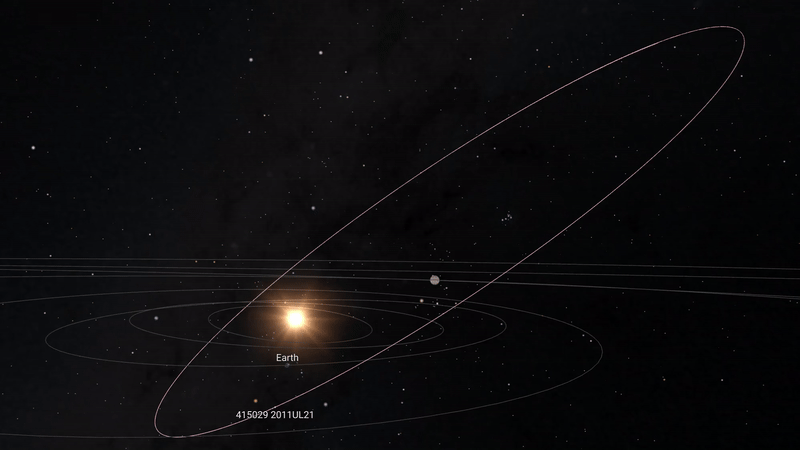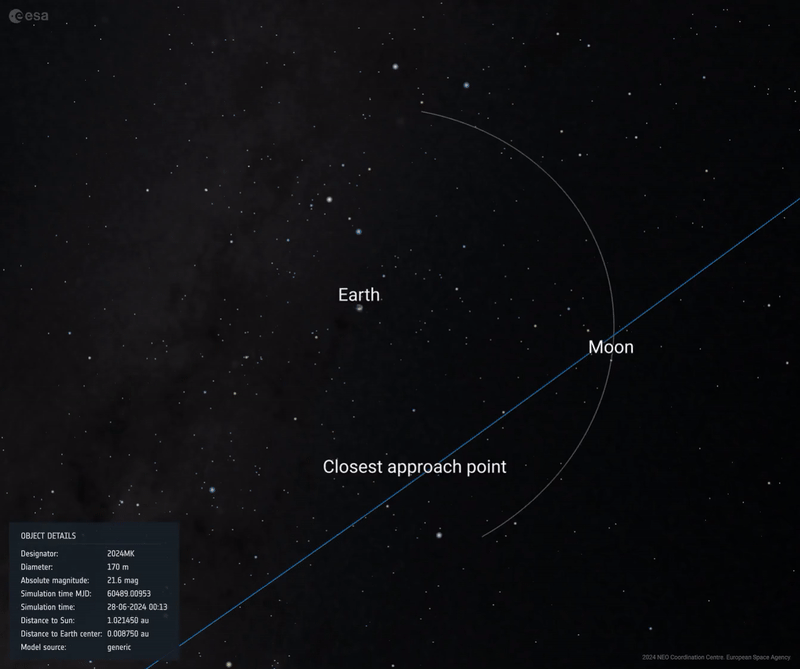Two Massive Asteroids Will Fly Past Earth This Week. Here’s What to Know
Within 42 hours of each other, the pair of large asteroids, which both have no chance of impacting our planet, will approach Earth as they orbit the sun
:focal(1750x1083:1751x1084)/https://tf-cmsv2-smithsonianmag-media.s3.amazonaws.com/filer_public/90/df/90dfeb2c-1659-4b56-969c-9c4255f9c2f7/space_safety_programme_-_near_earth_objects.jpg)
This week, two massive asteroids will pass closely by Earth just days apart—one on Thursday afternoon and one on Saturday morning—in time to ring in World Asteroid Day, celebrated annually on June 30, with a particularly special showing.
Both space rocks have a zero percent chance of hitting our planet, and that should come as a relief: The asteroids are so large that an impact by the first would be civilization-ending, and the second could destroy a city. But their closeness and likelihood of being visible—for those with telescopes—will offer astronomers and citizen scientists an exciting opportunity to catch a glimpse as they fly by.
A gargantuan space rock

At approximately 4:14 p.m. Eastern time on Thursday afternoon, the bigger of the two asteroids—called (415029) 2011 UL21—will pass Earth at a distance more than 17 times farther than our moon, or more than four million miles away. Still, at 7,600 feet long, it is one of the largest space rocks to come that close within the past 125 years.
Discovered in October 2011, the asteroid is larger than 99 percent of near-Earth objects (NEOs), though roughly ten times smaller than the Vredefort asteroid—the largest to ever hit Earth—and about five times smaller than the rock that wiped out the dinosaurs. Its elliptical orbit around the sun is steeply tilted, which is unusual for asteroids of its size, and it completes 11 solar revolutions every 34 Earth years.
/https://tf-cmsv2-smithsonianmag-media.s3.amazonaws.com/filer_public/64/a1/64a18566-d671-4df4-abd6-6f07042ed7a1/close_approach_of_asteroid_415029_2011_ul21.png)
As the asteroid passes our planet, the Virtual Telescope Project will stream live programming, so you can witness the rock’s approach wherever you are. If you’d rather spot it yourself, (415029) 2011 UL21 will be visible with small telescopes through Sunday, appearing brightest on Friday, writes EarthSky’s Eddie Irizarry.
A ‘city-killer’ asteroid

On Saturday morning, at 9:46 a.m. Eastern time, the smaller asteroid named 2024 MK will fly significantly closer to Earth, passing at about three-fourths the distance to the moon. Those with strong binoculars or a telescope might be able to identify the asteroid—which is between 400 and 850 feet long—as it rushes across the sky and appears as a small beacon of light. Those in Hawai’i or South America, astronomers say, will have the best view, though it will also be visible from the southern United States.
“The object will be moving fast, so you have to have some skills to spot it,” Juan Luis Cano, a member of the Planetary Defense Office at the European Space Agency, tells the New York Times’ Robin George Andrews.
The asteroid is at least double the size of the space rock for which World Asteroid Day was founded—the rock responsible for the 1908 Tunguska event, in which a roughly 160-foot-long asteroid crashed into a remote region of Siberia, wiping out 800 square miles of forest and releasing energy equivalent to 185 Hiroshima bombs.
Each year, astronomers recognize World Asteroid Day on the anniversary of this event. The space-focused holiday is supported by the United Nations to raise public awareness about the hazard of asteroid strikes.
/https://tf-cmsv2-smithsonianmag-media.s3.amazonaws.com/filer_public/82/09/8209c674-fa8e-4000-b1cc-5ebfde771934/close_approach_of_asteroid_2024_mk.png)
What does this mean for planetary defense?
2024 MK was discovered on June 16—only about two weeks before its closest approach to Earth. This timeline “highlights the ongoing need to improve our ability to detect and monitor potentially hazardous near-Earth objects,” according to a statement from the European Space Agency.
The European Space Agency’s Planetary Defense Office continues to discover and track the passage of asteroids and other NEOs. But “the case of 2024 MK is yet another reminder about the fact that there are a lot of large objects still to be found,” Cano tells the New York Times.
Currently, no known asteroid is on a path to impact Earth within the next 1,000 years. But there will be some close calls, in the near and more distant future. In April 2029, a 1,100-foot-long asteroid named Apophis will fly within 20,000 miles of our planet. And again in 2089, 2011 UL21 will return along its orbit, coming about two and half times closer than its approach on Thursday.
/https://tf-cmsv2-smithsonianmag-media.s3.amazonaws.com/accounts/headshot/ChristianThorsberg_Headshot.png)
/https://tf-cmsv2-smithsonianmag-media.s3.amazonaws.com/accounts/headshot/ChristianThorsberg_Headshot.png)